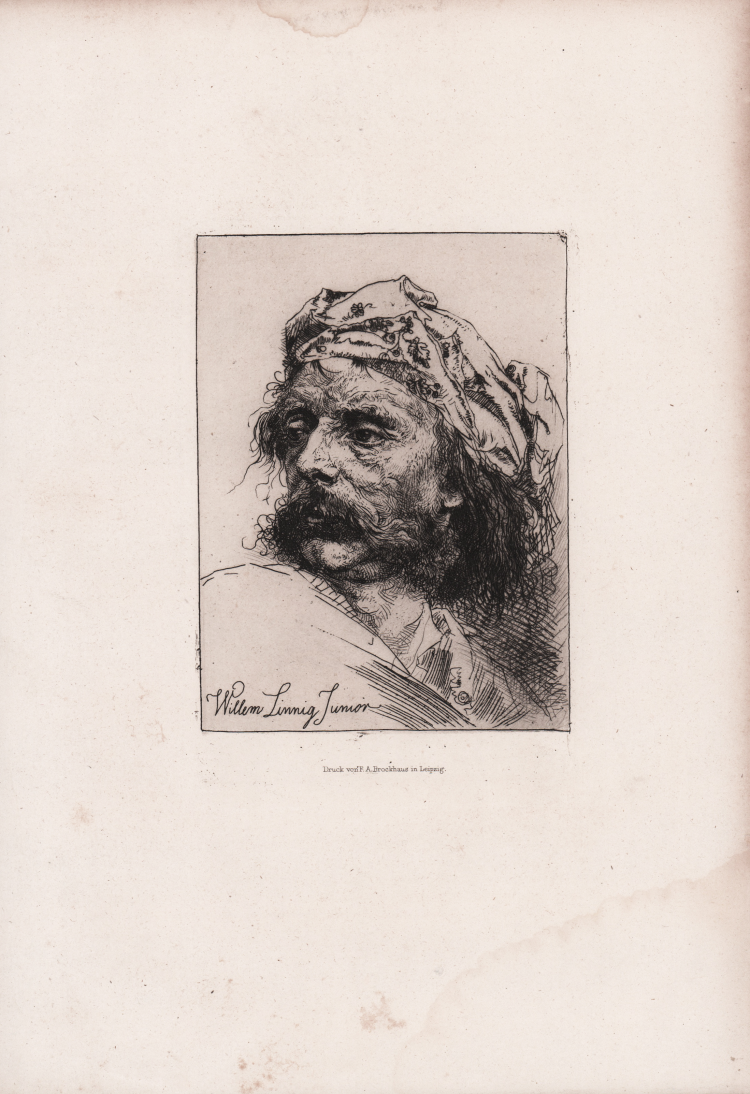



| Reference: | S42262 |
| Author | William II LINNIG |
| Year: | 1881 ca. |
| Measures: | 92 x 130 mm |


| Reference: | S42262 |
| Author | William II LINNIG |
| Year: | 1881 ca. |
| Measures: | 92 x 130 mm |
Study of a head of a man with turban; signed proof.
Etching and drypoint with surface tone. Lettered within image in lower left corner: "Willem Linnig Junior". From the series of etchings for 1881 published by the Gesellschaft für Radierkunst zu Weimar (the Society of Etchers in Weimar)
A fine impression, printed on contemporary wove paper, with margins, waterstain at the lower right margin, otherwise good condition.
Willem Linnig the Younger (August 20, 1842, in Antwerp - September 3, 1890, in Antwerp) was a Belgian painter and engraver, best known for his historical and genre scenes, landscapes and still lifes. Known as "The Younger", he was born in Antwerp as the son of Willem Linnig the Elder. Linnig was a very prolific painter and printmaker. He left behind a large number of paintings and 123 etchings. He worked on a wide range of subjects: history and genre scenes, landscapes and still lifes. Of the 123 etchings Linnig produced, 122 were of his own design and one was a reproductive etching of Rubens' Nymphs and Satyrs. He drew the lines with great care in his graphic work, but also showed a great level of exuberance.
Linnig came from a dynasty of celebrated Belgian artists, whose output was surveyed in a 1991 exhibition, with a catalogue by P. Verbraeken et. al., Linnig: Ein Antwerpse kunstenaarsdynastie in de 19de eeuw.
The catalogue of Linnig's etchings in French does not give a precise match for this. I assume this may be Linnig 67, Le contrabandier, but have no proof.
Bibliografia
P. Verbraeken, Linnig: Ein Antwerpse kunstenaarsdynastie in de 19de eeuw, n. 67.
|
Willem Linnig the Younger (August 20, 1842, in Antwerp - September 3, 1890, in Antwerp) was a Belgian painter and engraver, best known for his historical and genre scenes, landscapes and still lifes. Known as "The Younger", he was born in Antwerp as the son of Willem Linnig the Elder. Willem Linnig trained with his father and entered his father's studio at the age of 18. He made copies of drawings by Willem Jacob Herreyns, an important Antwerp painter around the end of the 18th century. He also studied the work of Rembrandt. Linnig continued to study at the Academy of Fine Arts in Antwerp, where the painter Jan Antoon Verschaeren, himself a student of Herreyns, was one of his teachers. He exhibited for the first time in 1867. Gradually he began to gain recognition with his realistic works.
Linnig was a very prolific painter and printmaker. He left behind a large number of paintings and 123 etchings. He worked on a wide range of subjects: history and genre scenes, landscapes and still lifes. His early works, such as The Antwerp Wedding, are in the realist style and show his strong skill as a colorist. During his stay in Germany his subject matter and style became more romantic. He was also influenced by 18th century French artists, who added a mannerist element to his work. After his return to Antwerp he painted mainly historical scenes not unlike those of the important history and genre painter Jan August Hendrik Leys who was one of his father's teachers. His still lifes of vegetables, sweets and other objects are very colorful and poetic. Of the 123 etchings Linnig produced, 122 were of his own design and one was a reproductive etching of Rubens' Nymphs and Satyrs. He drew the lines with great care in his graphic work, but also showed a great level of exuberance.
|
|
Willem Linnig the Younger (August 20, 1842, in Antwerp - September 3, 1890, in Antwerp) was a Belgian painter and engraver, best known for his historical and genre scenes, landscapes and still lifes. Known as "The Younger", he was born in Antwerp as the son of Willem Linnig the Elder. Willem Linnig trained with his father and entered his father's studio at the age of 18. He made copies of drawings by Willem Jacob Herreyns, an important Antwerp painter around the end of the 18th century. He also studied the work of Rembrandt. Linnig continued to study at the Academy of Fine Arts in Antwerp, where the painter Jan Antoon Verschaeren, himself a student of Herreyns, was one of his teachers. He exhibited for the first time in 1867. Gradually he began to gain recognition with his realistic works.
Linnig was a very prolific painter and printmaker. He left behind a large number of paintings and 123 etchings. He worked on a wide range of subjects: history and genre scenes, landscapes and still lifes. His early works, such as The Antwerp Wedding, are in the realist style and show his strong skill as a colorist. During his stay in Germany his subject matter and style became more romantic. He was also influenced by 18th century French artists, who added a mannerist element to his work. After his return to Antwerp he painted mainly historical scenes not unlike those of the important history and genre painter Jan August Hendrik Leys who was one of his father's teachers. His still lifes of vegetables, sweets and other objects are very colorful and poetic. Of the 123 etchings Linnig produced, 122 were of his own design and one was a reproductive etching of Rubens' Nymphs and Satyrs. He drew the lines with great care in his graphic work, but also showed a great level of exuberance.
|